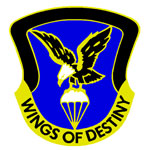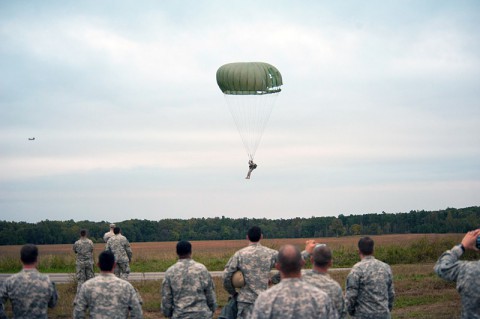Written by Sgt. Duncan Brennan
101st Combat Aviation Brigade


Fort Campbell, KY – Soldiers with F Company, 5th Battalion, 101st Combat Aviation Brigade, 101st Airborne Division (Air Assault,) Pathfinders, conducted a jump at Corregidor drop zone on Fort Campbell, KY, October 16th, 2013.
This jump was the last airborne exercise for the Pathfinders. The jump is being conducted because the Pathfinder companies are coming off jump status for the foreseeable future.
Taking the Pathfinders off of jump status is the end of an era. The Pathfinders of the 101st CAB trace their roots back to World War II.

Losing jump status is more than just about the history. The current soldiers that have inherited a rich legacy that remains alive today. Young soldiers coming into the company are excited to be part of rich traditions and a historically versatile unit.
“It’s sad to think that the Pathfinders are losing their jump status,” said Spc. Christopher Sylvester, F Company, 5-101st CAB, rifleman. “I just graduated airborne school last month. I’m excited about this jump; I just wish there were more to follow. Part of our job is to jump in ahead of other units and set up the drop and landing zones for follow-on forces.”
There is a tremendous amount of pride that roots itself in being airborne. At the 101st Airborne, whose first rendezvous with destiny was led by the Pathfinders jumping into Normandy.
“Morale will take a hit,” said Staff Sgt. Brendan Dougherty, F Company, 5-101st CAB, Pathfinder team leader. “We’ve been airborne ever since the Pathfinders were established under the 82nd Airborne Division. For some of the guys, this is their first duty position, and to be able to come to the 101st and still jump, it’s still a big thing. The airborne status itself is something that sets a lot of infantry apart from non-airborne infantry. An airborne soldier will walk around barrel chested thinking that he can take on the world and I think that pride pushes them to work harder.”
The esprit de corps present in the Pathfinder company is a direct reflection of what the Wings of Destiny, and the Army calls on them to do. The missions of the Pathfinders are more focused than what normal infantry sees. They are skilled at recovery of personnel and aircraft, reconnaissance, and, most notably, for setting up drop and landing zones for inbound paratroopers or air assaults. Because of the missions that the Pathfinders fulfill, having a tool box that has the broadest capabilities is imperative.
Airborne insertion is only one way our skills can be delivered, said Beville. We can air assault in, which gives us the most exact delivery, but when that’s not possible we can jump, truck or ruck our way in to where we need to be. Jumping is, by far, our most discrete method. Being able to get into an area quietly is often instrumental in not kicking the hornets’ nest.
It may be the end of being on jump status, but it is not the end of the road. Pathfinders thrive in adverse environments. The loss of airborne status is another obstacle to overcome.
“Jumping into an operation is only one method of insertion,” said Staff Sgt. James Tucker, 101st Airborne Division master jump master. “The mission of the Pathfinders is more than just static-line airborne. It is not too far-fetched to say that they will quickly find a way to overcome and work around this limitation. Even though we’re losing this historical airborne capability, the next best thing is around the corner.”
With all of the changes that are at play, and all of the uncertainty of the future, the legacy of the Pathfinders will endure.
“It’s really fitting for the Pathfinder company to make the last jump in the 101st Airborne,” said 1st Sgt. Daniel Cromer, F Company, 5-101st CAB, Pathfinders. “It really goes with our unit motto ‘First in, last out.’ It was Capt. Frank Lilliman who jumped first into Normandy during Operation Overlord with the Pathfinder company and it will be the Pathfinder company making the last jump in this division’s storied history.”








